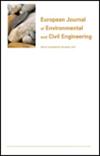Flexible barrier and flow-driven woody debris: an experimental investigation of their interaction
IF 2.3
4区 工程技术
Q2 ENGINEERING, CIVIL
European Journal of Environmental and Civil Engineering
Pub Date : 2023-10-15
DOI:10.1080/19648189.2023.2268706
引用次数: 0
Abstract
AbstractFlexible barriers have been recently proposed as a promising alternative for trapping woody debris driven by the flow in torrents and rivers before they reach elements at risks. Small-scale experiments in similitude with the real-scale have been conducted in view of addressing the interaction between the flow and the barrier. A particular attention was paid to the identification of the parameters with influence on the loading experienced by the barrier, varying the woody debris mixtures characteristics, water discharge, flume inclination and woody debris supply mode. This investigation emphasised the intricacy of the relation between the barrier loading and the characteristics of the trapped logs and of the logs accumulation. The barrier loading revealed inversely proportional to the woody debris accumulation permittivity, which quantifies its capacity to let the water seep through. Permittivity depended on the way the accumulation built up and on the evolution of its characteristics with increasing discharge and trapped logs volume. Finally, the loading exerted by the flow on the barrier was derived from the barrier elongation, revealing that it could be modelled as a hydrostatic load with a reduction factor of 0.5.Keywords: driftwoodfloodflexible barrierflume experimentloading AcknowledgementsThe authors would like to thank Ana-Rocio CERON-MAYO who performed the experiments and contributed to the previous analysis, Hervé BELLOT and Alexis BUFFET for their help in designing the experimental set up and two anonymous reviewers for providing helpful comments on a previous version of this article.Disclosure statementNo potential conflict of interest was reported by the authors.Data availability statementAll data generated or used during the study are available in a repository online in accordance with funder data retention policies: FilTor: Interaction between flexible barriers and flows (INRAE), https://data.inrae.fr/dataverse/filtor, backwater rise and LW releases: https://doi.org/10.15454/RMIEJM, and flexible barrier elongation measurement: https://doi.org/10.15454/9HUDGG.Additional informationFundingThis work was funded by the French Ministry of Environment (Direction Générale de la Prévention des Risques—Ministère de la Transition Ecologique et Solidaire) within the multirisk Agreement SRNH-IRSTEA 2019 (Action FILTOR).柔性屏障和流动驱动木屑:它们相互作用的实验研究
摘要柔性屏障最近被提出作为一种有前途的替代方案,用于在水流和河流中驱动的木屑到达危险元素之前将其捕获。为了研究流动与障壁之间的相互作用,进行了与实尺度相似的小尺度实验。特别注意识别影响屏障所受载荷的参数,改变木屑混合特性、水量、水槽倾角和木屑供应方式。这项研究强调了屏障载荷与被困测井特征和测井堆积特征之间关系的复杂性。屏障荷载与木屑堆积介电常数成反比,该介电常数量化了其让水渗透的能力。介电常数取决于堆积的形成方式及其特征随放电和圈闭测井体积的增加而变化。最后,流动对屏障施加的载荷由屏障伸长率推导而来,表明它可以被建模为具有0.5折减系数的静水载荷。作者要感谢Ana-Rocio CERON-MAYO进行了实验并对之前的分析做出了贡献,herv BELLOT和Alexis BUFFET帮助设计了实验设置,两位匿名审稿人对本文之前的版本提供了有益的评论。披露声明作者未报告潜在的利益冲突。数据可用性声明根据资助者数据保留政策,研究过程中产生或使用的所有数据均可在在线存储库中获得:过滤器:灵活屏障和流动(INRAE)之间的相互作用,https://data.inrae.fr/dataverse/filtor,回水上升和LW释放:https://doi.org/10.15454/RMIEJM,以及灵活屏障伸长测量:https://doi.org/10.15454/9HUDGG.Additional信息资助这项工作由法国环境部(指导snh - irstea 2019多风险协议(行动过滤器)中的snh - irstea 2019(指导snh - irstea 2019)资助。
本文章由计算机程序翻译,如有差异,请以英文原文为准。
求助全文
约1分钟内获得全文
求助全文
来源期刊

European Journal of Environmental and Civil Engineering
ENGINEERING, CIVIL-ENGINEERING, GEOLOGICAL
CiteScore
4.80
自引率
4.80%
发文量
153
审稿时长
6 months
期刊介绍:
The European Research Area has now become a reality. The prime objective of the EJECE is to fully document advances in International scientific and technical research in the fields of sustainable construction and soil engineering. In particular regard to the latter, the environmental preservation of natural media (soils and rocks) and the mitigation of soil-related risks are now not only major societal challenges, but they are also the source of scientific and technical developments that could be extremely beneficial.
 求助内容:
求助内容: 应助结果提醒方式:
应助结果提醒方式:


